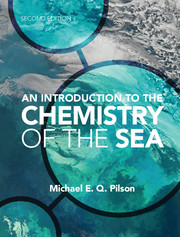Book contents
- Frontmatter
- Contents
- Preface
- Acknowledgments
- 1 Introduction
- 2 The water in seawater
- 3 Salinity, chlorinity, conductivity, and density
- 4 Major constituents of seawater
- 5 Simple gases
- 6 Salts in solution
- 7 Carbon dioxide
- 8 Nutrients
- 9 Trace metals and other minor elements
- 10 Radioactive clocks
- 11 Organic matter in the sea
- 12 Anoxic marine environments
- 13 Exchanges at the boundaries
- 14 Chemical extraction of useful substances from the sea
- 15 Geochemical history of the oceans
- Appendix A The chemical elements
- Appendix B Symbols, units, and nomenclature
- Appendix C Physical properties of seawater
- Appendix D Gases
- Appendix E Carbon dioxide
- Appendix F Dissociation constants and pH scales
- Appendix G Solubility of calcium carbonate
- Appendix H Effects of pressure
- Appendix I Radioactive decay
- Appendix J Geochemical reservoirs, and some rates
- Appendix K Sound absorption
- Epilogue
- Questions for chapters
- Glossary
- References
- Index
- Miscellaneous end matter
- References
10 - Radioactive clocks
Published online by Cambridge University Press: 05 February 2013
- Frontmatter
- Contents
- Preface
- Acknowledgments
- 1 Introduction
- 2 The water in seawater
- 3 Salinity, chlorinity, conductivity, and density
- 4 Major constituents of seawater
- 5 Simple gases
- 6 Salts in solution
- 7 Carbon dioxide
- 8 Nutrients
- 9 Trace metals and other minor elements
- 10 Radioactive clocks
- 11 Organic matter in the sea
- 12 Anoxic marine environments
- 13 Exchanges at the boundaries
- 14 Chemical extraction of useful substances from the sea
- 15 Geochemical history of the oceans
- Appendix A The chemical elements
- Appendix B Symbols, units, and nomenclature
- Appendix C Physical properties of seawater
- Appendix D Gases
- Appendix E Carbon dioxide
- Appendix F Dissociation constants and pH scales
- Appendix G Solubility of calcium carbonate
- Appendix H Effects of pressure
- Appendix I Radioactive decay
- Appendix J Geochemical reservoirs, and some rates
- Appendix K Sound absorption
- Epilogue
- Questions for chapters
- Glossary
- References
- Index
- Miscellaneous end matter
- References
Summary
. . . every radioactive mineral can be regarded as a chronometer registering its own age with exquisite accuracy.
Arthur Holmes 1913The presence of natural radioactive isotopes of numerous elements in the ocean and throughout Earth provides us with a wealth of accurate clocks by which it is possible to determine the rates of many important processes. Their evaluation has provided us with an assured sense of the timescales of many geological and oceanic phenomena. The supplemental introduction of anthropogenically produced radioactive isotopes has in many cases provided opportunities to obtain additional information.
The existence of radioactivity, and what we have learned from the radioactive elements, has profoundly affected our comprehension of the world around us, but all this has come about only recently. A little over 100 years ago, the age of Earth was estimated by physicists (e.g. Lord Kelvin in 1897) as being only 20 to 40 × 106 years, because the laws of physics did not allow that it could take much longer than that to cool from a molten ball to its present state. Geologists by then knew that Earth must be much older, but saw no escape from the laws of physics. Then radioactivity was discovered, and the consequences were rapidly explored by Becquerel, Marie and Pierre Curie, Rutherford, Soddy, Thompson, Strutt, Holmes, and others. It was a wonderfully productive time in science (see Faure 1986 for a brief review and entrée to the history). The radioactive elements present in the composition of Earth provided a source of heat sufficient to keep the interior hot for the necessary length of time and also provided several accurate clocks by which the geological timescale could be calibrated. By 1913, Holmes had established that some ancient rocks were as much as 1.6 × 109 years old, and our general appreciation of the true age of Earth was pretty well settled. Subsequently, the age of Earth and of at least some other bodies in the Solar System has been established at around 4.6 × 109 years, with relatively small uncertainties, all by observing several of the natural radioactive clocks. With regard to the oceans, our knowledge of the rates of renewal of deep water and the rates of transport and sedimentation of many substances has come in large part from investigating these clocks.
Information
- Type
- Chapter
- Information
- An Introduction to the Chemistry of the Sea , pp. 261 - 286Publisher: Cambridge University PressPrint publication year: 2012
